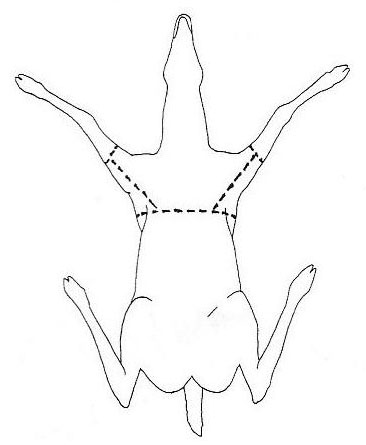Trophy Field Care – After the Hunt
Caping for a shoulder mount
For whitetail deer we prefer to receive the entire hide in one piece, attached to the head only. This allows for form variances and different shoulder lengths.
Skin the deer from the hind legs to the shoulders. At the shoulders, make a cut at the hair pattern on the back of the front legs where the white and brown hair meet. Use this as a guide to cut along the back of the front legs toward the body, avoiding the armpit area, to the sternum (center of the ribcage). This will make a V-shaped cut on the bottom of the ribcage that will accommodate any form that you select. You will then skin down past the shoulders, cutting the head off at the base of the neck leaving the skin attached. We take measurements from skin only so it is not necessary to leave any neck meat attached (keep this and enjoy the neck roast!) Most deer processors are familiar with the skinning technique necessary for a shoulder mount.
Small Mammals
For coyotes and other smaller mammals, please leave the skinning to us. Do not gut the animal. Because of their thinner skins, smaller mammals, particularly carnivores (such as coyotes) spoil quickly. If you cannot get the animal to the studio immediately, allow the carcass to cool completely, then wrap it in a plastic bag and freeze it. During the winter months, a safe outdoor location is fine. Keep it out of direct sunlight!
Birds
Rinse any blood from the feathers with plain water as soon as possible. Do not gut the bird. It is important to get the bird to the studio or freeze it as quickly as possible. If freezing, wrap the bird gently in a plastic bag, taking care not to damage any feathers, including the tail. If the tail feathers will not fit into the bag, don’t bend them, either wrap them with another bag or let them stick out and tie the bag loosely.
For turkeys in particular, care in the field is of extreme importance for a quality end result. After harvesting the bird, get the bird off the ground as quickly as possible, lifting the bird by the head rather than the neck. It is vital to not let the bird flop on the ground in order to avoid feather damage. Do not carry the bird out of the field in a game bag as this causes damage and bending of feathers. Carry the bird over your shoulder by the legs, taking care to prevent feather damage.
Lifesize Big Game Animals
The ventral incision method is used for rug mounts and lifesize poses. Use the diagram below as a guide for making the necessary incisions, cutting the feet free from the carcass but leaving them attached to the skin. The head is removed in the same manner as for a shoulder mount, cutting it off where the neck and head meet, leaving the head attached to the skin without any unnecessary neck meat. (see above.)

